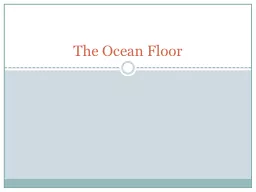

Features of the Ocean Floor Continental Shelf Zone of shallow water where the ocean covers the end of the continent Shallow slope Where most ocean life is found Why Answer Photic zone is the first 100 feet of water and allows sunlight to penetrate the water ID: 478769
Download Presentation The PPT/PDF document "The Ocean Floor" is the property of its rightful owner. Permission is granted to download and print the materials on this web site for personal, non-commercial use only, and to display it on your personal computer provided you do not modify the materials and that you retain all copyright notices contained in the materials. By downloading content from our website, you accept the terms of this agreement.
Slide1
The Ocean FloorSlide2
Features of the Ocean FloorSlide3
Continental Shelf
Zone
of shallow water where the ocean covers the end of the continent.
Shallow slope
Where most ocean life is found. Why?
Answer: Photic zone is the first 100 feet of water and allows sunlight to penetrate the water. Slide4
Continental Slope
Continental slope is a very steep slope off the continental shelf.
Here, the ocean becomes very deep.
Submarine canyons are carved out by underwater landslides called
turbidity currents.Slide5
Continental Rise
Sediments from the submarine canyons are deposited further out in the ocean.
These sediments form the continental rise.
It is here that the continental crust ends and oceanic crust begins. Slide6
Abyssal Plain
A
large, flat, almost level area of the deep-ocean basin
Abyssal plains cover about half of the deep-ocean basins and are the flattest regions on Earth.
Layers of fine sediment cover the abyssal plains. Slide7
Mid-Ocean Ridge
Formed by divergent plate boundary.
Magma rises as plates pushed apart.
Forms underwater mountain range of volcanoes.
These ridges can cause sea level to rise and fall drastically. Slide8
Guyots
and Seamounts
Guyot
: A flat-topped underwater mountain. Formerly an island that was eroded and sank into the ocean.
Seamounts: Pointed-topped underwater mountain ranges that were likely volcanic.
Hawaii will become seamounts and guyots. Slide9
Trenches
Deepest point in the ocean.
Have the most pressure.
Formed from convergent boundaries where one plate dives beneath another (
Subduction
zone).Often form Island Arcs like Japan or Philippines. Slide10
Ocean Floor SedimentsSlide11
Sediments
Clastics
:
Sand, silt, mud, and clay found on continental shelf make up the thickest sediments.
Biogenic Sediments:
Calcium carbonate and Silica from organisms like forams and diatoms leave oozes on the ocean floor that form Chert
(Silica from diatoms) and Chalk (Calcite from
forams
). Also limestone (calcite).
Chemical Sediments:
Nodules of manganese, copper, iron, and nickel can form and be found scattered on the ocean floor.